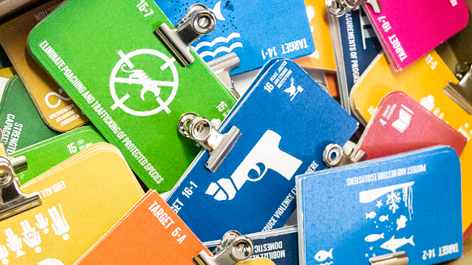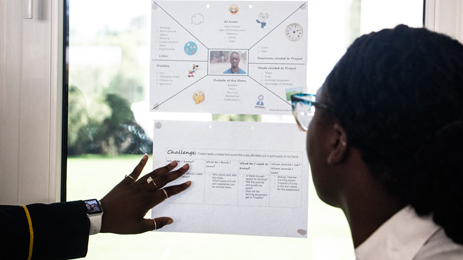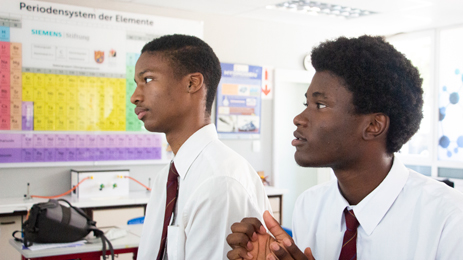
»We want our children to be independent thinkers, and to be prepared for the global world.«
Sustainable by design: pursuing the SDGs through Design Thinking
Design Thinking is a methodology for human-centered design and problem solving that has found a foothold in several areas of society: technology and innovation, business, service delivery, and urban planning. While the methodology’s creative, human-centered approach to problem solving has been prevalent at tertiary education institutions for years, primary and secondary schools are now bringing Design Thinking to their classrooms. The project “Design Thinking in STEM”, initiated by Siemens Stiftung and The Index Project, focuses on utilizing the methods of Design Thinking in pursuit of the Sustainable Development Goals (SDGs). The following stories of teachers and learners at three South African schools capture how the new methodology has impacted the classroom experience.
A spotlight on schools in Durban, Johannesburg, and Cape Town
In 2019, Siemens Stiftung set out to train 25 teachers from South Africa on the Design Thinking methodology, with an emphasis on STEM subjects. Since then, the teachers have worked together with their learners in Durban, Johannesburg, and Cape Town on the urgent problems outlined by the SDGs. They developed concrete solutions that left a lasting impact on both the teachers and the learners.
Gender equality, sustainable consumption, and climate protection – most SDGs are of major global concern and are well-suited to a thorough examination in STEM subjects. At the same time, the Design Thinking methodology takes these lessons further by providing learners with tools for understanding the meaning of the SDGs on a personal and local level.
Design thinking our way to a sustainable future
The SDGs established by the United Nations can be used to create a thematic structure for interdisciplinary STEM lessons. When applied in the classroom, the Design Thinking methodology is useful for making complex STEM subjects, such as clean drinking water or sustainable power generation, more approachable.
Quality education, gender equality, and a lot of empathy
I took everything out of the classroom, and set it up for a ‘new beginning’.
According to the teachers from Thomas More College in Durban, an introduction to the methods of Design Thinking “changed the way [they] looked at teaching.” Bringing the Design Thinking process into the classroom “shifted their role from teacher to facilitator” as learners discovered how to shape their own projects and experiences. It even changed the physical setup of the classroom: “When I came back from the workshop, I took everything out of the classroom and rearranged it for a ‘new beginning.’ There was no group setting before,” says Genevieve Saville, who teaches design in grades 9–12.
Electra, a tenth grade student, enjoys the new method. “It’s great that we do not have to stick with our first idea. We get to develop it further and even have the freedom to change our minds. It was also nice to create a final product in the end – you see your hard work pay off!” Her favorite stage was ideation, which she also utilizes in art class. Another student in 12th grade reflected similarly on the process: “I like that it makes the idea creation more structured, but not so much that you cannot jump from one idea to another or make changes. It essentially gives you a path to follow.”
The learners in the design class work in groups and create their own challenges based on one of the SDGs of their choosing. Examples include designing a better teacher training experience (SDG 4: Quality Education) or examining gender-based violence (SDG 5: Gender Equality); “the issue of sexual harassment is very common in Durban,” said one student. The process allows learners to look beyond their personal experience with these problems and to explore situations in which the problem may be worse. This provides insights into how their problem-solving efforts can best be put to use.
Preparing us for life after school.
Genevieve, the teacher from Thomas More College, says it is rewarding to see learners come to this conclusion. One student said: “I think this is a really nice way of learning because it is practical, which is way better than memorizing. It really teaches us problem solving and prepares us for life after school.”
Technology teacher Vincent Oberholzer introduced a hydroponics project to his eighth grade class: “There are links to quite a few of the SDGs. [Previously, we would] know what we’re doing, we’d know how we’re doing it, but the kids always asked why we’re doing it. Now, we’ve added the ‘why’ to it, which makes a big difference.”
The persona map works like a bomb.
Vincent said he considers the most important aspect of the Design Thinking process to be the persona map, saying it “works like a bomb.” Empathy is indeed a core value of Design Thinking, and his students seem to agree: “It feels great trying to help people even if we are not really doing it. Just the thought of it is great. We put ourselves in the shoes of the people we are trying to help.”
Both teachers at Thomas More College were backed by the rest of the school and, most importantly, the principal. Going forward, the school is planning on conducting Design Thinking workshops for the entire staff, including teachers from different subjects and departments. Ultimately, the school would like to reach a point where teachers from different subjects can take on different aspects of the same, multidisciplinary project. It’s an idea that has paid off in classes that combine design, engineering, and graphic design (EGD).
Creative solutions for renewable energy and responsible consumption
Students are less scared of failure, and more willing to take risks.
Lilo MacLachlan, a chemistry teacher at the German International School in Johannesburg, uses Design Thinking to prepare her students for the national Science Expo. But her lessons also prepare them for life after school. “We want our children to be independent thinkers who are prepared for the wider world,” she says. “Design Thinking made the expo projects more real by giving them a purpose. It’s a shift to work on real life problems, but the students feel they can make a difference and be useful. They are less scared of failure and more willing to take risks.”


During a gallery walk, her students present their science projects. Each is linked to a specific SDG, ranging from alternative sources of renewable energy (SDG 7: Affordable and Clean Energy), to plastic use (SDG 12: Responsible Consumption and Production), to bug farming as an affordable and sustainable food source (SDG 2: Zero Hunger). The students believe the Design Thinking process helped improve their projects because they started approaching the problems from a different perspective. One group pointed out the importance of user interviews, which made the solutions “more tangible, and one can empathize with the user.” The process has also shifted the focus away from getting good marks. Instead, students are taught to focus on exploring, failing fast, and learning through the experience. When learners were asked to describe the process in one word, terms like creativity, freedom, or guidance were the most prevalent. Some learners have even felt empowered to apply the process outside of science class: “It’s a lot about problem solving and I think you can use it in everyday life.”
Expanding the teacher toolbox: Learning the value of ‘life below water’
Compared to the other two schools, Floreat Primary School in Cape Town is a more modestly resourced school situated in the heart of the city’s working-class southern suburbs. While an abundance of resources has the potential to add value to any project, the beauty of the Design Thinking approach is that resources do not dictate success. A passionate educator willing to disrupt the status quo by introducing a better methodology for preparing students for a dynamic future is more important.
The authenticity brings out the energy.
Even with resource constraints, large class sizes, and a lack of space, primary school teacher Kristi Jooste managed to introduce Design Thinking to her seventh grade class. “There was an energy in the room because it was real, and it’s the authenticity that brings out the energy.”
Her students use the process in projects about the health of the oceans as described in SDG 14: Life Below Water. It is a process they enjoy: “The persona map really helped us to see what the problem is. Building a prototype was difficult, but it helped a lot. When we tested the prototypes, some of them worked, and some broke.” One student saw the potential in using the process to prepare for high school: “I think I will use this process throughout my life, even outside of school. Maybe for an interview when I prepare to go to high school. The process would help me identify things like what am I nervous about, how to overcome my fears – I believe it would help a lot!”
Using Design Thinking in class has given me more scope.
Kristi sees an overall improvement to the quality of the projects since students work on real problems and not scenarios constructed specifically for the classroom. “The methodology has given me a skeleton to use, even though it didn’t necessarily revamp my teaching. But it’s a very useful tool to add to our ‘teacher toolbox’ and has given me more scope.”
If she had the capacity, Kristi says she would teach Design Thinking to her colleagues. Ideally, she says, she would employ one mentor per group, slow down the overall curriculum, and do Design Thinking for the whole term – across all disciplines, not just one subject. In contrast to traditional education and its focus on students learning specific content, the process itself is where the learning takes place in Design Thinking. For learners, the new way of learning has proven to be a valuable asset, as evidenced by their willingness to use the approach to prepare for high school.
Get in touch and share your learnings!
What are your experiences with applying Design Thinking in class?
Would you like to share your insights or connect with other teachers in our network? We look forward to hearing from you!
Christine Niewöhner
christine.niewoehner@siemens-stiftung.org
+49 89 540487 119


